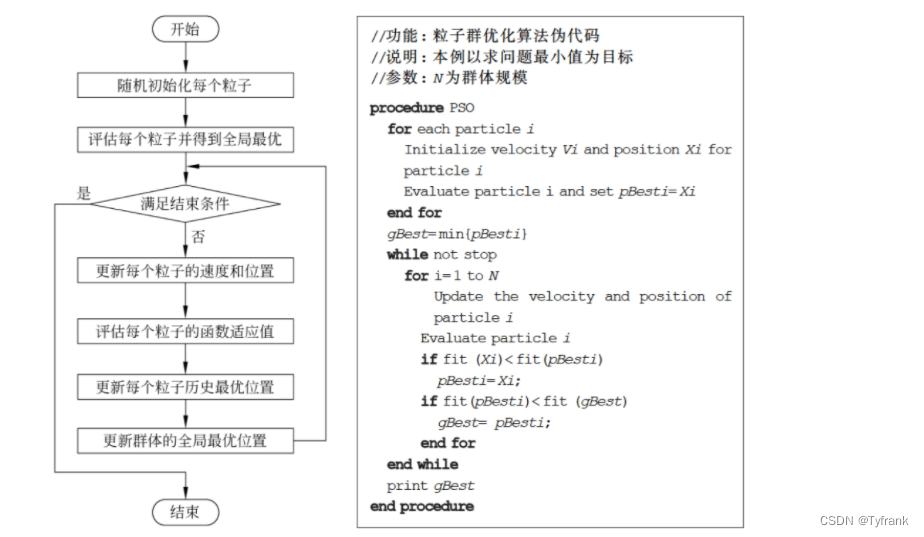粒子群算法机器学习进阶:提升模型性能秘诀
发布时间: 2024-07-20 07:50:16 阅读量: 49 订阅数: 25 


# 1. 粒子群算法概述
粒子群算法(Particle Swarm Optimization,PSO)是一种受鸟群或鱼群等群体智能行为启发的优化算法。它通过模拟群体中个体的互动和学习,来寻找最优解。PSO算法具有易于实现、计算效率高、鲁棒性强等优点,广泛应用于机器学习、图像处理、工程优化等领域。
在PSO算法中,每个个体(粒子)都表示一个潜在的解决方案,其位置和速度不断更新,以向最优解移动。粒子群中每个粒子不仅会受到自身经验的引导,还会受到群体中其他粒子的影响,从而实现群体协作优化。通过这种迭代更新机制,粒子群算法能够有效地探索搜索空间,并最终收敛到最优解附近。
# 2. 粒子群算法的理论基础
### 2.1 粒子群算法的原理
#### 2.1.1 粒子个体的表示和更新
粒子群算法中,每个粒子代表一个潜在的解决方案,由其位置和速度两个属性表示。位置表示粒子在搜索空间中的当前位置,速度表示粒子移动的方向和速度。
```python
class Particle:
def __init__(self, position, velocity):
self.position = position
self.velocity = velocity
def update(self, pbest, gbest):
# 更新速度
self.velocity = self.velocity + c1 * np.random.rand() * (pbest - self.position) + c2 * np.random.rand() * (gbest - self.position)
# 更新位置
self.position = self.position + self.velocity
```
#### 2.1.2 粒子群的优化过程
粒子群算法的优化过程是一个迭代的过程,包括以下步骤:
1. **初始化粒子群:**随机初始化粒子群中的粒子。
2. **评估粒子:**计算每个粒子的适应度值。
3. **更新粒子:**根据适应度值更新每个粒子的位置和速度。
4. **更新全局最优解:**找出所有粒子中适应度值最高的粒子,将其位置作为全局最优解。
5. **更新个体最优解:**找出每个粒子在历史中适应度值最高的粒子,将其位置作为个体最优解。
6. **重复步骤 2-5,直到达到终止条件:**通常是达到最大迭代次数或适应度值不再改善。
### 2.2 粒子群算法的变种
为了提高粒子群算法的性能,提出了多种变种算法。
#### 2.2.1 惯性权重策略
惯性权重是一个因子,用于控制粒子的速度。随着迭代次数的增加,惯性权重逐渐减小,以帮助粒子收敛到最优解。
```python
def update_inertia_weight(iteration, max_iteration):
return 0.9 - 0.5 * iteration / max_iteration
```
#### 2.2.2 局部最优和全局最优的平衡
粒子群算法容易陷入局部最优解。为了解决这个问题,提出了多种策略,例如:
* **拓扑结构:**将粒子组织成不同的拓扑结构,如环形拓扑或星形拓扑,以增强粒子之间的信息交换。
* **社会学习:**粒子不仅从自己的历史最优解和全局最优解学习,还从邻居粒子的最优解学习。
### 2.3 粒子群算法的收敛性分析
#### 2.3.1 粒子群算法的收敛条件
粒子群算法的收敛性取决于以下条件:
* 粒子群的规模
* 惯性权重
* 学习因子
* 搜索空间的维度
#### 2.3.2 粒子群算法的收敛速度
粒子群算法的收敛速度取决于以下因素:
* 粒子群的规模
* 惯性权重
* 学习因子
* 搜索空间的复杂度
# 3.1 粒子群算法优化神经网络
#### 3.1.1 粒子群算法优化神经网络的权重
**原理:**
粒子群算法优化神经网络的权重时,将每个神经元视为一个粒子,粒子群的搜索空间为神经网络的权重空间。粒子群算法通过迭代更新粒子的位置和速度,逐步逼近最优权重值。
**步骤:**
1. **初始化粒子群:**随机初始化粒子群,每个粒子表示一组神经网络权重。
2. **评估粒子适应度:**计算每个粒子的适应度,即神经网络在给定数据集上的性能。
3. **更新粒子位置和速度:**根据粒子的适应度和历史最优位置,更新粒子的位置和速度。
4. **更新全局最优位置:**记录所有粒子中适应度最高的粒子位置,作为全局最优位置。
5. **重复步骤 2-4:**迭代执行上述步骤,直到达到终止条件(如最大迭代次数或适应度收敛)。
**代码示例:**
```python
import numpy as np
class PSO:
def __init__(self, n_particles, n_dimensions):
self.n_particles = n_particles
self.n_dimensions = n_dimensions
self.particles = np.random.rand(n_particles, n_dimensions)
self.velocities = np.zeros((n_particles, n_dimensions))
self.best_positions = np.zeros((n_particles, n_dimensions))
self.best_global_position = np.zeros(n_dimensions)
self.best_global_fitness = float('inf')
def update(self):
for i in range(self.n_particles):
# 更新粒子速度
self.velocities[i] += (self.best_positions[i] - self.particles[i]) * np.random.rand() + \
(self.best_global_position - self.particles[i]) * np.random.rand()
# 更新粒子位置
self.particles[i] += self.velocities[i]
# 更新粒子最优位置
fitness = self.evaluate(self.particles[i])
if fitness < self.best_positions[i]:
self.best_positions[i] = self.particles[i]
# 更新全局最优位置
if fitness < self.best_global_fitness:
self.best_global_position = self.particles[i]
self.best_global_fitness = fitness
def evaluate(self, particle):
# 计算粒子的适应度
return np.sum((particle - self.target)**2)
# 使用 PSO 优化神经网络权重
pso = PSO(n_particles=100, n_dimensions=100)
for i in range(1000):
pso.update()
print(pso.best_global_position)
```
**参数说明:**
* `n_particles`:粒子群中粒子的数量
* `n_dimensions`:神经网络权重空间的维度
* `particles`:粒子群中粒子的位置
* `velocities`:粒子群中粒子的速度
* `best_positions`:每个粒子的历史最优位置
* `best_global_position`:全局最优位置
* `best_global_fitness`:
0
0





